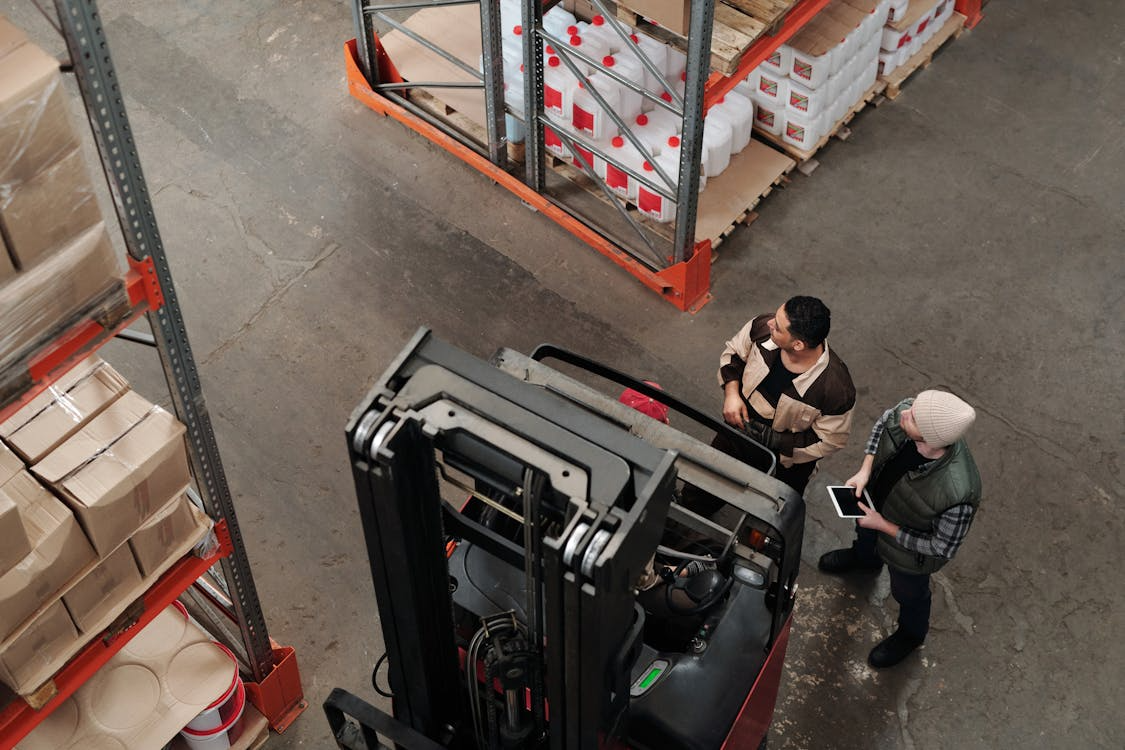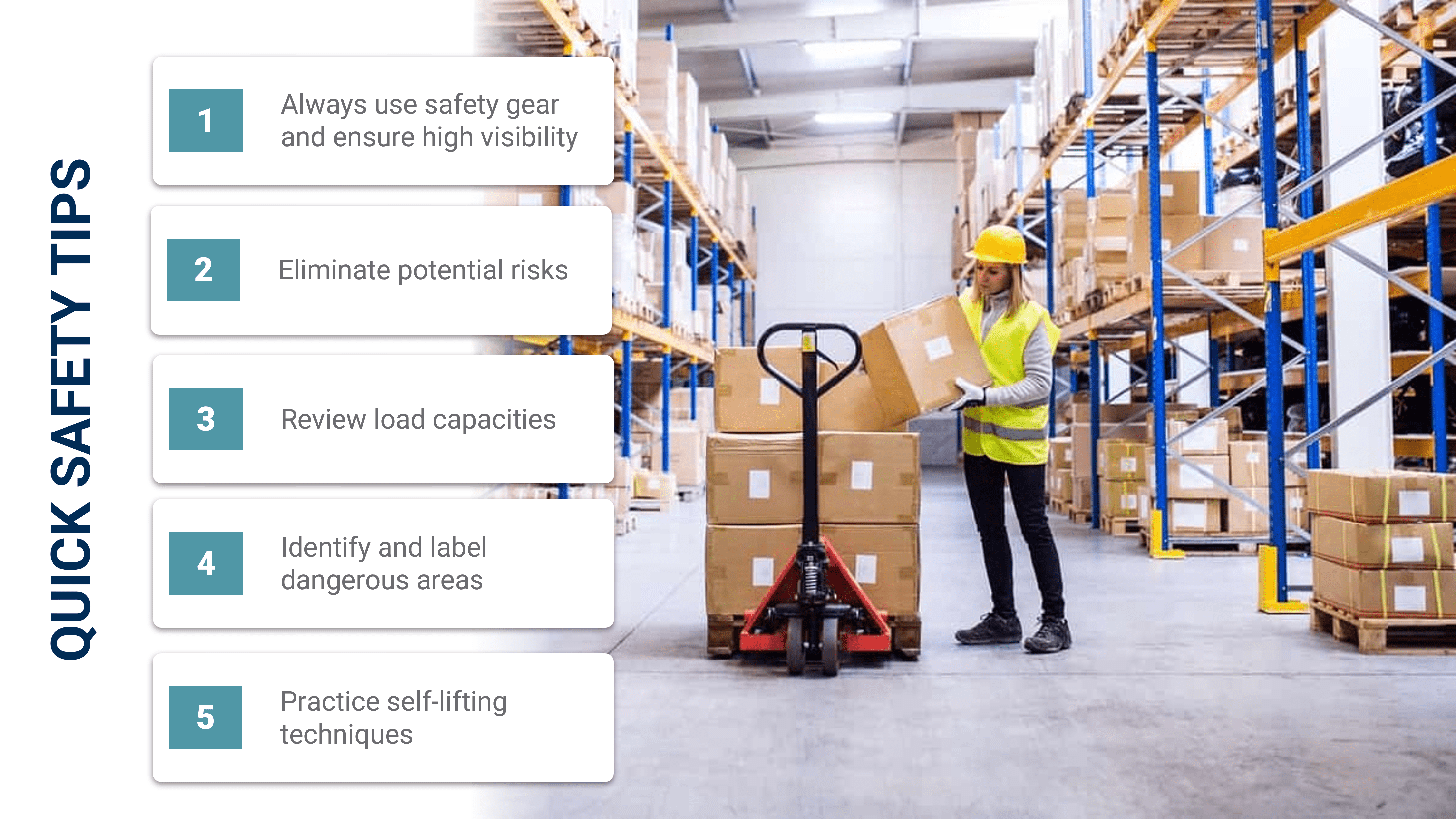By Theresa Bontempo
Ensuring the smooth running of logistics and supply chain operations is the responsibility of all warehouse workers. When working conditions are hazardous and not considered safe, this can pose various risks that could negatively affect the well-being and overall operations of a company. This is why it is so important to make sure you are always following proper safety procedures at your company.
In order to establish a secure work environment, a warehouse owner must follow proper safety protocols and regulations. This approach can help protect workers from various hazards, as well as bring about positive effects on both parties.
Compliance with safety standards and regulations can also help create a secure work atmosphere and minimize the risk of injury or damage to property. It shows a firm commitment to being good corporate citizens and helps protect the well-being and safety of both the public and workers.
What are the Most Common Hazards in Warehouses?
In warehouses, the lack of lighting, uneven surfaces, and cluttered walkways are some of the factors that contribute to the accidents that cause falls, trips, and slips. These can lead to various health conditions, such as fractures, head injuries, or even fatalities. A worker might get severely injured after falling from an elevated platform.
Heavy Lifting
When it comes to heavy lifting, workers are prone to getting injured. In addition to improper techniques, such as the lack of training, workers might also get injured due to the lack of mechanical aids and equipment. One can easily get injured within areas particularly like the back or shoulders.
Equipment Malfunctions
Working with various types of equipment, such as forklifts and conveyor belts, can expose workers to various potential workplace accidents. Misuse, equipment malfunctions, and collisions can lead to serious injuries or even fatalities. A forklift accident can cause severe head injuries or even kill a worker if the proper safety procedures are not followed.
Hazardous Materials
Working in warehouses is often associated with handling dangerous materials, such as toxic gases, chemicals, and flammable substances. Exposure to such substances can cause various health conditions, including cancer. In addition to improper handling methods, the lack of ventilation and inadequate protective equipment can also increase the risks of exposure.
What are the Benefits of Prioritizing Warehouse Safety?
In order to maintain a safe and productive workplace, warehouse managers must prioritize worker safety. This can be done through education and training, as it can help improve the overall environment and prevent injuries. Having a safe warehouse can also boost employee morale and decrease turnover.

By implementing safety guidelines in the warehouse, managers can make the workplace more harmonious and efficient. Doing so not only helps with industry standards, but it also promotes a culture of good work.
Better Sense of Morale
Creating a positive safety culture can help boost employee morale. Material handling employees are well aware of the hazards they face due to the fast-paced environment they work in, and they want to feel safe at work. They must trust that their employers will prevent them from getting injured. Having a well-defined safety policy can also help boost employee morale, as it provides clear expectations and helps them feel safe at work.
Productivity & Efficiency
When safety is a top priority for warehouse operations, the workplace becomes more productive and efficient. It fosters a more collaborative atmosphere, as staff members are less likely to get injured and the work flow is less disrupted by potential hazards or accidents.
By implementing strict safety procedures and keeping the warehouse premises hazard-free, leadership can ensure smooth operations. This proactive approach can minimize the impact of accidents on the work flow, allowing staff members to focus on their duties properly.
In addition to improving the efficiency of the warehouse, having a comprehensive safety program can also help boost worker productivity and make the workplace more harmonious. This program should cover the various aspects of the warehouse's operations.
Reduced Turnover Rates
One of the biggest benefits of implementing safety guidelines in the warehouse is a reduction in turnover rates, which is because employees are more likely to stay with the organization if they feel that their managers take the necessary steps to ensure safety.
A firm commitment to safety fosters trust and loyalty among workers, thereby increasing job satisfaction and prompting fewer people to look for employment elsewhere.
Reducing the Risks
There are many risks associated with warehouse operations, and proper management can help prevent injuries. It is important to address these hazards in order to maintain a safe working environment.
Use of Ergonomics
High-use areas within warehouses require proper ergonomics in order to reduce risk of injury, and one of the most common reasons for workplace injuries is improper use of ergonomics. A common issue that can affect an employee's health is the repetitive movements of a workstation. For instance, employees may have to get in and out of a forklift multiple times to perform simple tasks. Although these issues may seem minor to warehouse safety, they can still lead to long-term effects.
Conduct Training Programs
Every employee of the warehouse should be trained on how to perform their duties correctly and be aware of the safety procedures in place in the event of an accident. In-person and online training sessions are usually conducted for employees. These sessions are usually combined with regular safety audits and drills. Online training courses cover various safety measures, such as fire safety measures and protective equipment. These are typically required quarterly.
In order to make sure that workers are safe, the warehouse's management can implement effective safety programs. These can include instructing employees on the latest safety tips.

One of the most important advantages of implementing digital training material is its practicality. It allows employees to easily refer to emergency procedures or follow proper maintenance techniques while on the job which ensures that the warehouses are running properly and that workers are not putting themselves at risk.
Effective Communication
In environments where there is a high risk of injury, effective communication is essential. A framework that aims to inform all team members about potential hazards within the warehouse should be established. Such initiatives can help management reduce the risk of injuries and accidents by establishing a safe work environment.
A technology-based reporting framework can help improve the safety of warehouses by allowing management and workers to communicate regularly about the status of their work environment. This system will also notify all staff members of any accidents, injuries, or hazards. This framework can address various issues such as equipment breakdowns, slips and trips, and spills involving hazardous substances.
Managing Fire & Electrical Safety Hazards
When it comes to the well-being of employees, fire safety is a vital topic. Companies must take the necessary steps to ensure that their facilities are fire-proof, such as installing fire extinguishers and emergency exits. But they should also focus on preventing electrical and fire hazards in warehouses.
The majority of workplace workstations contain various tools and components, which makes them essential areas for organization. When it comes to using technology, such as tablets and scanners, it can be hazardous to handle multiple wires. To minimize the risk of fire and electrical hazards, it is important to install docking stations that have all the necessary power and ports.
Keeping Equipment Secure
It is important that all equipment used in a warehouse is placed in a secure position so that workers can avoid falling and getting injured. This includes heavy equipment such as ladders and shelving.
This ensures the safety of workers while giving them the assurance that their equipment is secure, which also helps improve the efficiency and productivity of the warehouse.
Top 5 Ways in Which Digital Signage is the Perfect Solution for Warehouse Safety
Digital signage can help managers inform and educate their employees about the safety procedures and protocols in their factories. This approach can also reduce incidents and provide a secure environment for workers.
White-collar employees can use digital signage as a secondary channel for accessing important information, while non-desk workers can use it as their primary communication method.
Sharing company news, general information, and HR data is made easy with digital signage, which can help workers feel valued and engaged in the company. This can result in more loyalty and buy-in. In addition, this method lets employees receive real-time updates from business apps, which can improve transparency and accuracy.
Check out exactly how digital signage can be used to prioritize safety within your company!
1. Improve Health & Safety Overall
Digital signs can help employees identify potential hazards and bring attention to potentially dangerous surroundings. By being constantly aware of their surroundings, individuals can take the necessary steps to prevent problems. Whenever there is an emergency, an alert on digital signs can inform workers immediately, which also provides important information about the next steps.
2. Improve the Production Procedure
A digital signage system can help distribute production notifications efficiently and effectively. It can help improve the transparency of various departments and enable them to work together to achieve the same goal. This type of communication eliminates information gaps and ensures that all departments have the same access to the latest updates.
By allowing for an effective production process, this can help create a secure work atmosphere and reduce the risk of accidents.
3. Ensuring Proper Guidance
People who are new to a manufacturing facility may find it hard to navigate through the various areas of the building. Having digital signs can help make your life easier for visitors, which can help them avoid getting injured or getting lost somewhere in the complex.
Visitors can easily navigate through digital signage, which provides a variety of navigation tools and information. It can also promote events and amenities, as well as provide users with real-time updates about the status of their location. Compared to static signs, digital displays offer a more flexible and engaging experience. They are best used in complex environments to manage crowds and provide timely information.
4. Making Sure Goals are Met
To promote a culture of safety, digital signage can be utilized to display goals and metrics that can help employees stay informed about ongoing initiatives. Signs in common areas can also help keep track of the days that have gone by without an incident.
5. Cybersecurity Awareness & Compliance
To help employees become more aware of the importance of cybersecurity, digital signage should be placed in high-traffic locations such as hallways. This can help them identify potential threats and implement effective measures to protect themselves. Creating strong passwords, avoiding phishing emails, and ensuring that Wi-Fi networks are secure are some examples to keep a company secure and protected.
Employees are often required by organizations to follow certain regulations, such as HIPAA, PCI, and GDPR. Having digital signage that clearly communicates these requirements can help employees easily become acclimated.
Digital signage can be used in warehouses to communicate important safety messages in multiple languages, which can help reduce miscommunication. Shift can help promote a culture of safety by consistently displaying incident statistics and training reminders. Image courtesy of Shift.
Why Shift?
By integrating digital signage solutions such as Shift, warehouse safety can be improved by allowing employees to communicate with each other and with the outside world through real-time updates to safety procedures and hazards. Dynamic displays promote a culture of safety and help reduce accidents by giving employees step-by-step instructions, providing vital emergency contact information, and helping them stay well.
















